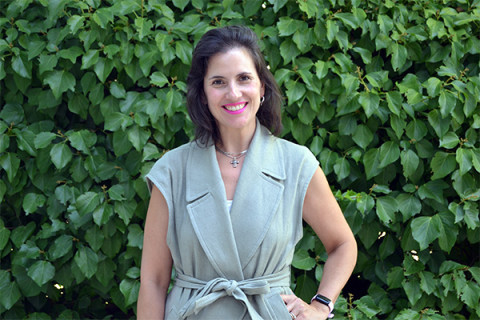Amparo Ruiz Carretero, new visiting researcher at ICMM

Amparo Ruiz Charretero is a researcher fascinated by supramolecular chemistry and organic electronics. She comes from the Institute Charles Sadron in Strasbourg and will spend more than a year in the Multifunctional and Supramolecular Materials group. Meet her here:
Where do you come from?
I come from the Institute Charles Sadron in Strasbourg (France). I am a permanent CNRS (Centre National de la Recherche Scientifique) researcher and the group leader of team SYCOMMOR (SYstemes COmplexes Moleculaires et Macromoleculaires ORganises) in my origin institution.
What have you worked on so far?
I did my Ph.D. between Ciudad Real (Univ. Castilla - la Mancha) and Eindhoven (The Netherlands), a postdoc at Northwestern University in Chicago, and another one at the University of Strasbourg. My research has been inspired by mainly two fascinating scientific fields: supramolecular chemistry and organic electronics. Throughout my career, I have combined both, namely supramolecular electronics.
During my independent career, I have developed different research lines focused on the incorporation of noncovalent interactions into conjugated materials. In addition, we incorporate chiral materials to explore the Chiral Induced Spin Selectivity (CISS) effect. This way, we can guide charges and electron spins selectively and improve the yield of organic photovoltaic devices. Our goal is to offer alternative energy materials based on organic compounds forming supramolecular structures. We are going through a worrying energy crisis and we want to contribute to solving it by providing alternative materials that can be used together with the current energy technologies. We will need all of them if we keep on our current energy consumption!
What will you work on? With whom?
I will work with Berta Gomez-Lor, Eva Maya, Felipe Gandara, and other members of the Multifunctional and Supramolecular Materials group. Also, with a member of my team who is coming to ICMM as well. We are planning to continue our research lines at the ICMM, and learn as much as possible from experts in the institute on surface science and spintronics.
We would like to introduce new research lines into the ICMM based on supramolecular electronics and chiral materials while interacting with experts who can teach us new techniques and advance our work. We will get involved in other projects of the group and contribute to our vision.
Why ICMM?
I was attracted to ICMM due to the quality of its research and because of the great opportunity to introduce new research projects that align with my hosting group and the institute in general. The fact that physics is a strong point of the ICMM is also very important, despite the fact that I am an organic chemist. I think I can learn a lot from them and collaborate. Furthermore, the institute has very good communication with other neighboring institutions, which is very relevant to starting new collaborations and interacting with other colleagues. I can see as well how dynamic the institute is and the multiple activities organized here.
And a personal touch: any hobbies? What would you like to contribute to the institute?
My hobbies are cooking, fashion, urban tourism, and Hispano-American literature.
I love participating in outreach activities and promoting equality. I am the organizer of the IUPAG Global Breakfast in my origin institution and also a member of the Equality Commission of a cluster of excellence of the University of Strasbourg. I love motivating young people, interacting with them, and bringing science education from an early age. I am very active on social media as well and I use them mainly to show that they can be very positive when you use them correctly and with respect. I am a very dynamic person, so if you see me around the ICMM, please come and talk to me, I'll be happy to discuss!
From a purely scientific point of view, I hope to contribute with new research lines, learn new concepts, and inspire the scientific community to advance energy materials from a supramolecular chemistry level.
ICMM
Sor Juana Ines de la Cruz, 3
Cantoblanco, 28049
Madrid, España
Teléfono: (+34) 91 334 90 00
Email: @email
Oficina de Comunicación/Prensa: @email

Acknowledge the Severo Ochoa Centres of Excellence program through Grant CEX2024-001445-S/ financiado por MICIU/AEI / 10.13039/501100011033

Contacto | Accesibilidad | Aviso legal | Política de Cookies | Protección de datos